Chinese embroidery, one of the outstanding traditional Chinese handicraft arts, refers to the needlework made on the fabrics in patterns of colorful characters, animals, or objects. As women make most embroidery works, embroidery is also called Nv Gong (women's work). Chinese embroidery originated from people's need for self-decorating. It is said that the painted patterns appeared as far as in Yellow Emperor's period, which means that the ancient primitive people already knew how to use colors to beautify themselves. It's just they applied paintings directly on their bodies. With the development of silk and fabrics, such painted patterns began to appear on clothes.
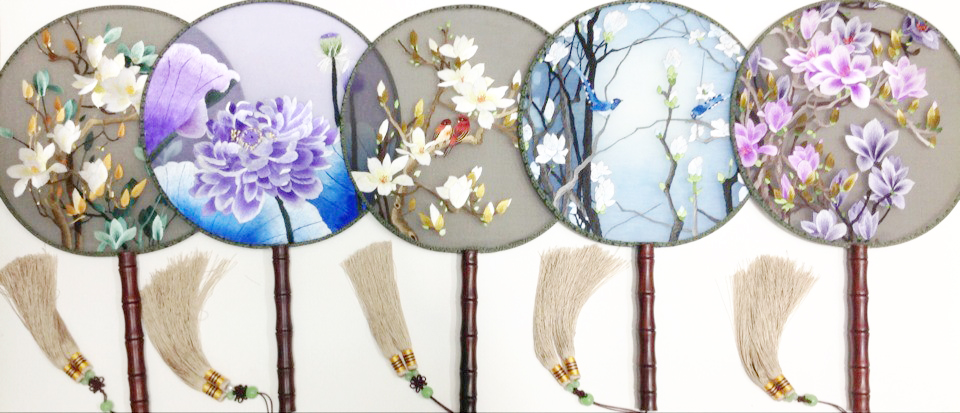
The earliest embroidery works found at present are the two pieces of silk embroidery excavated in the Chu tombs of Changsha, Hunan, that can be traced back to the Warring State Period. They were utterly made in lock stitching method with tidy pins, elegant colors, and smooth lines,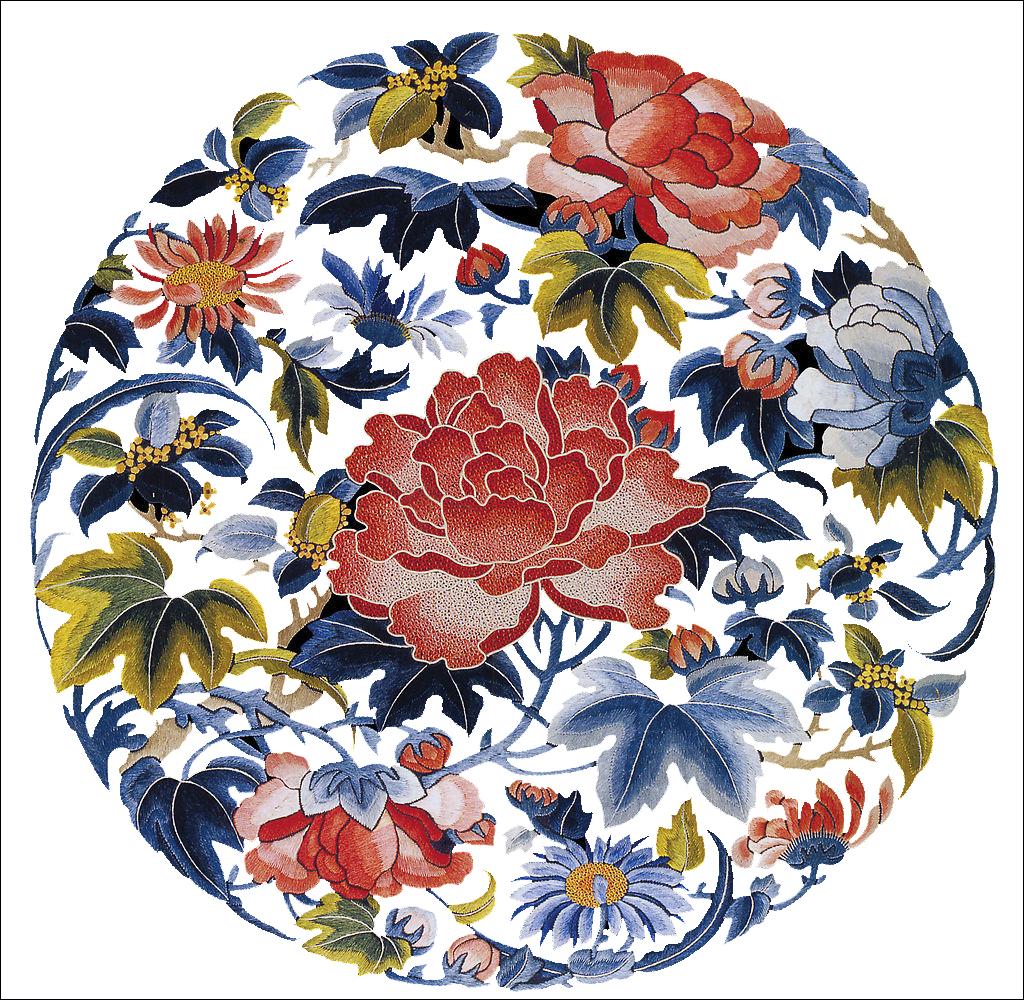 vividly embroidering the swimming dragons' patterns, flying phoenixes, and powerful tigers and showing the embroidery achievements of Chu State in the Warring State Period.
vividly embroidering the swimming dragons' patterns, flying phoenixes, and powerful tigers and showing the embroidery achievements of Chu State in the Warring State Period.
Han Dynasty embroidery works are discovered in many places, like Thousand-Buddha Cave in Dunhuang, Wuluchong Tomb in Hebei, northern Inner Mongolia, and a tomb at Astana nearby Turpan. The most famous excavation of Han dynasty embroideries is from the Mawangdui ruins of Changsha. There were a lot of diversified pieces discovered, greatly showing the Han era embroidery styles. The Han era embroidery patterns and themes were mostly wavy clouds, flying birds like a phoenix, or running sacred animals, or the patterns common on Han mirrors from those embroidery works. The base materials used in those embroidery works were popular in the Han dynasty, and the stitching style was still mainly lock stitch. The Han era embroideries feature big full patterns, neat stitches, and incredibly smooth lines.
The embroideries from Eastern Jin to Northern Dynasties unearthed in Dunhuang, Hetian, Bachu, and Turpan are all in lock stitching style. 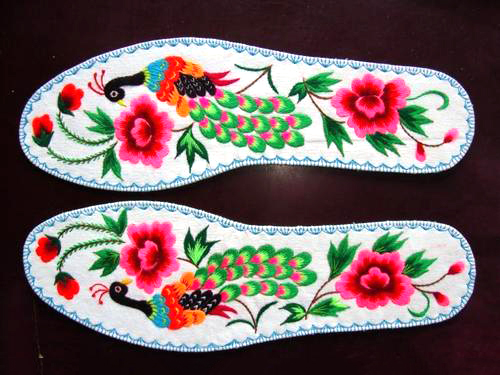 In 1965, a fraction of embroidery Buddha belonging to Guangyang King Yuan Jia of Northern Wei Dynasty was discovered in a rock crack in front of cave No.125 and 126 in Mogao Caves, Dunhuang, Gansu. It was offered by the Guangyang King in the eleventh year (487) of the Taihe era of the Northern Wei Dynasty. A Buddha sits in the center with a bodhisattva on the right and the providers' figures on both sides of the Buddha. The vowing text said that it was produced by Guangyang King Hui An (Yuan Jia). The whole piece used both lock stitches and back lock stitches, which were innovated and developed based on the Han era lock stitch. The significant colors used were red, yellow, and green. The red color was used primarily on the figures' clothes and partial muscular lines of nose, ears, hands, and feet. Green colors were mainly used in graphic patterns, while the purple color was used on the crown and boots.
In 1965, a fraction of embroidery Buddha belonging to Guangyang King Yuan Jia of Northern Wei Dynasty was discovered in a rock crack in front of cave No.125 and 126 in Mogao Caves, Dunhuang, Gansu. It was offered by the Guangyang King in the eleventh year (487) of the Taihe era of the Northern Wei Dynasty. A Buddha sits in the center with a bodhisattva on the right and the providers' figures on both sides of the Buddha. The vowing text said that it was produced by Guangyang King Hui An (Yuan Jia). The whole piece used both lock stitches and back lock stitches, which were innovated and developed based on the Han era lock stitch. The significant colors used were red, yellow, and green. The red color was used primarily on the figures' clothes and partial muscular lines of nose, ears, hands, and feet. Green colors were mainly used in graphic patterns, while the purple color was used on the crown and boots.
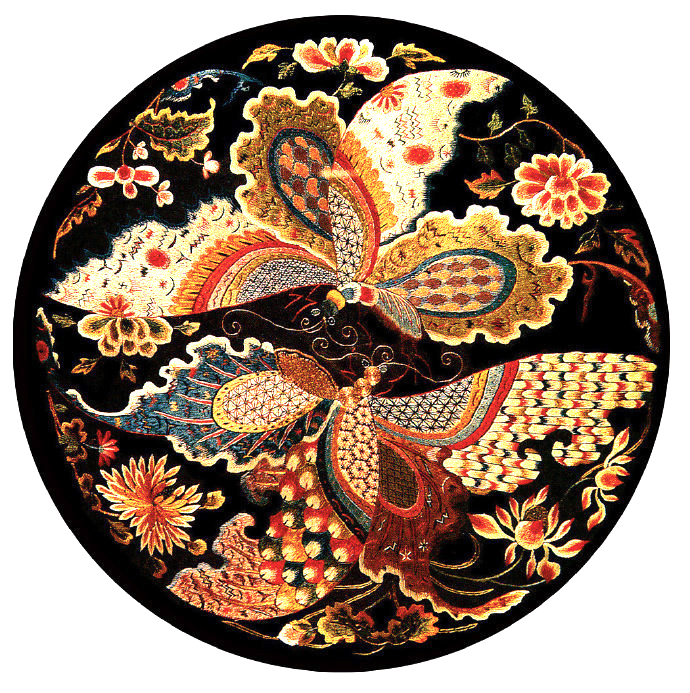
Tang Dynasty embroidery is closely related to the Tang era religious development. There are quite some Tang era embroideries with Buddha figures. Besides that, patterns commonly seen in paintings like landscapes, birds, pavilions, attics, flowers were also prevalent. The embroidery technique still followed the lock stitch in the Han Dynasty, but a new kind of method, flat embroidery, appeared. Meanwhile, the base materials used in Tang era embroidery were not confined to brocade and silk anymore. There were several other base materials, and the streaks were diversified. The different stitching methods and threads were used to create more vibrant, bright, and beautiful patterns. Also, gold and silver threads began to be used to draw the designs and enhance the stereoscopy, which can be regarded as an innovation in Tang era embroidery.
Before the Tang dynasty, the embroidery was mainly decorative and practical, and the patterns were related to daily needs and social customs. During Song Huizong's reign, a special department for embroidery was established to take charge of the Song imperial court's embroidery works. The embroidery paintings were classified into landscapes, pavilions, human figures, and flowers & birds. The result was that many famous embroidery masterpieces emerged, driving the embroidery paintings to the highest point. Besides, the practicability of embroidery was weakened, and its artistic quality was reinforced. 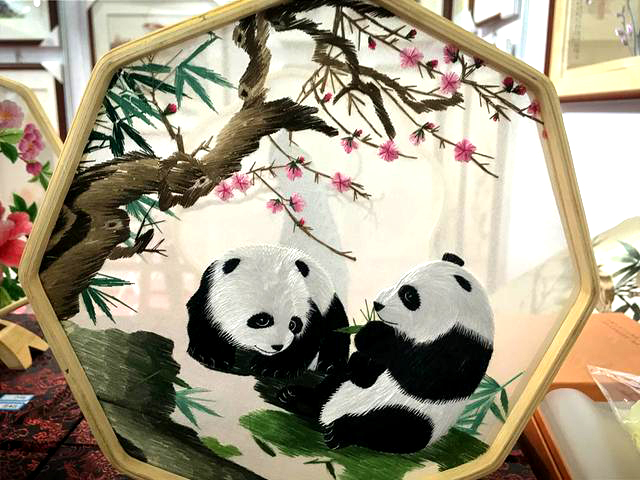 The calligraphy and painting styles began to have an even more profound impact on the embroidery creations. People modeled after the famous works of calligraphy and painting to form a unique ornamental embroidery.
The calligraphy and painting styles began to have an even more profound impact on the embroidery creations. People modeled after the famous works of calligraphy and painting to form a unique ornamental embroidery.
To achieve the vividness of calligraphy and paintings, a specific plan must be made before the embroidering, and changes can be made if necessary during the embroidering process. The layout of the patterns must be simple and have blank space. There are several sentences in Secret Records of Yuqing Xuan authored by Ming dynasty Dong Qichang that illustrate how delicate Song embroidery was. It says that Song embroideries have delicate and neat stitches. The threads are as thin as a hair, and the colors are spectacular and splendid. The mountains and rivers on the embroideries can be either far away or very close. The pavilions seem three-dimensional; the figures have vivid looks; birds and flowers seem very real. Some embroideries are even more vivid than paintings.
There are few embroideries of the Yuan Dynasty discovered. 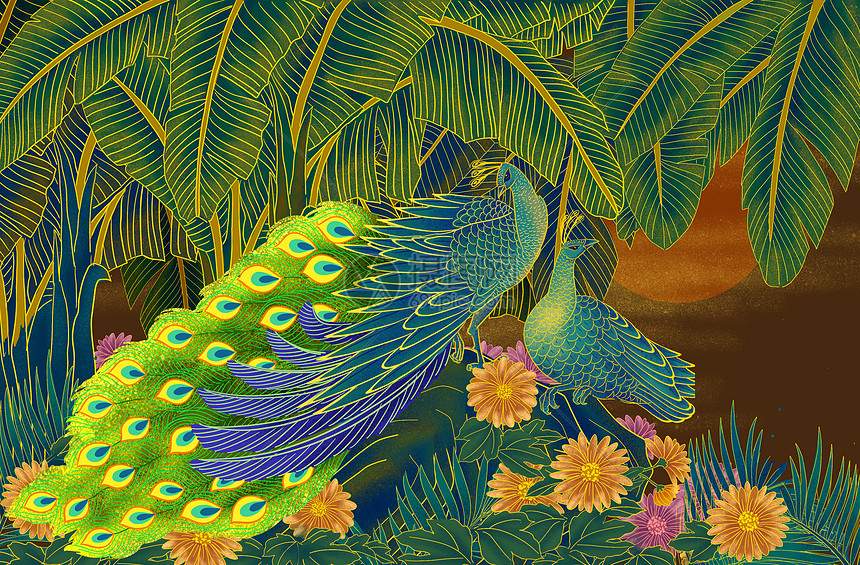 Taipei Palace Museum has one piece of Yuan era embroidery. Judging from this work, the Yuan-era embroidery was similar to that of the Song era, except the stitches were not very fine and neat. Yuan dynasty rulers believed in Lamaism, which greatly influenced the embroidery styles. Besides the decorations on clothing, the embroideries were mainly used to make Buddha statues, scrolls, and monks' hats. The masterpiece Embroidery Guhyasamaja Figure collected in Potala Palace of Tibet is a representative. In Yuan dynasty Li Yu'an's Tomb, there was a piece of embroidery unearthed. In addition to the several stitching methods, pasting thin silk was also used.
Taipei Palace Museum has one piece of Yuan era embroidery. Judging from this work, the Yuan-era embroidery was similar to that of the Song era, except the stitches were not very fine and neat. Yuan dynasty rulers believed in Lamaism, which greatly influenced the embroidery styles. Besides the decorations on clothing, the embroideries were mainly used to make Buddha statues, scrolls, and monks' hats. The masterpiece Embroidery Guhyasamaja Figure collected in Potala Palace of Tibet is a representative. In Yuan dynasty Li Yu'an's Tomb, there was a piece of embroidery unearthed. In addition to the several stitching methods, pasting thin silk was also used.
The dye and weaving techniques of the Ming Dynasty became developed in Xuande's reign.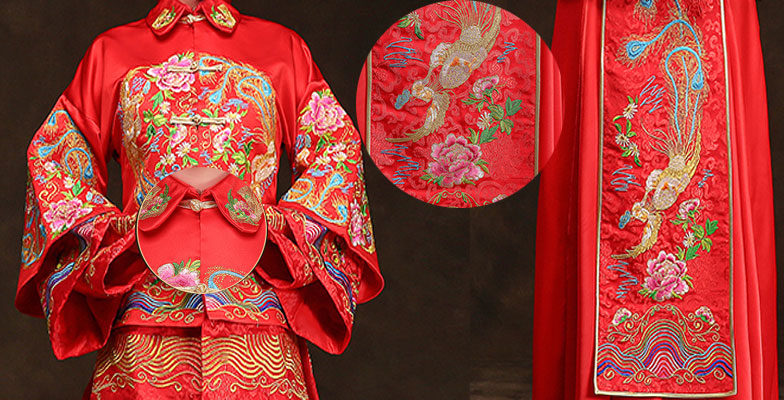 The most novel and prominent stitching method was sprinkling stitching embroidery that used two twisting yarns. The patterns were mainly geometric patterns. During Jiaqing's Reign, Gu family embroidery in Shanghai became very famous. Gu Shouqian and his wife Han Ximeng excelled in the hair embroidery of the Tang and Song eras. They modeled after the calligraphy works and paintings of celebrities and made embroideries just as vivid as the original works. People called this embroidery the Gu style embroidery.
The most novel and prominent stitching method was sprinkling stitching embroidery that used two twisting yarns. The patterns were mainly geometric patterns. During Jiaqing's Reign, Gu family embroidery in Shanghai became very famous. Gu Shouqian and his wife Han Ximeng excelled in the hair embroidery of the Tang and Song eras. They modeled after the calligraphy works and paintings of celebrities and made embroideries just as vivid as the original works. People called this embroidery the Gu style embroidery.
In the Qing Dynasty, the embroideries used by the imperial court must undergo two procedures. 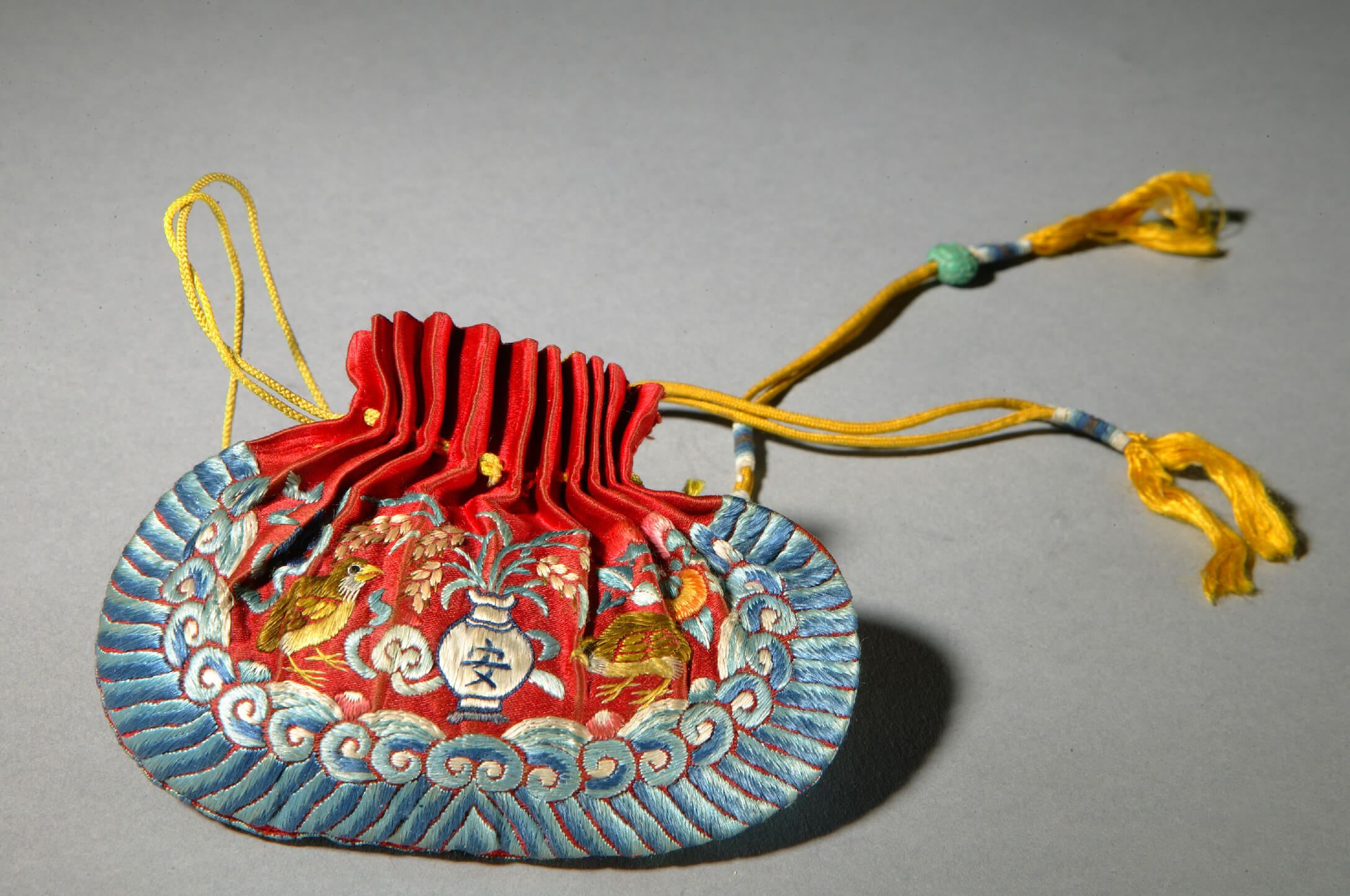 The patterns must be painted by the court's painters first and then presented to the relevant department for review. After being reviewed and approved, these patterns are passed to the three weaving and embroidery workshops under the jurisdiction of Jiangnan Manufacturing Bureau. Therefore, the court embroideries were extremely delicate. Besides the imperial embroideries, many local embroideries emerged, including Lu embroidery, Yue embroidery, Xiang embroidery, Peking embroidery, Su embroidery, Shu embroidery, and many more. Among them, local embroideries of Suzhou (Su), Sichuan (Shu), Guangdong (Yue), and Hunan (Xiang) were the most famous ones. They are known as four extraordinary embroideries.
The patterns must be painted by the court's painters first and then presented to the relevant department for review. After being reviewed and approved, these patterns are passed to the three weaving and embroidery workshops under the jurisdiction of Jiangnan Manufacturing Bureau. Therefore, the court embroideries were extremely delicate. Besides the imperial embroideries, many local embroideries emerged, including Lu embroidery, Yue embroidery, Xiang embroidery, Peking embroidery, Su embroidery, Shu embroidery, and many more. Among them, local embroideries of Suzhou (Su), Sichuan (Shu), Guangdong (Yue), and Hunan (Xiang) were the most famous ones. They are known as four extraordinary embroideries.
Su embroidery is a combination of random stitch embroidery in Danyang and Baoying, 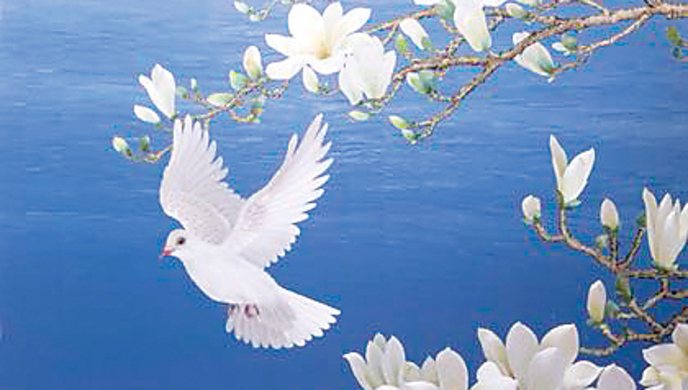 emulation embroidery in Nantong, antique embroidery in Yangzhou, and hair embroidery in Chetai. It has a long history and is developed by absorbing the Gu style embroidery's characteristics and strengths. In terms of embroidering techniques, Su embroidery mainly used the loop stitches, making it hard to perceive any stitch trace. Three or four kinds of same or similar colored threads are usually used to achieve the sfumato result. Meanwhile, there is often space between the deep and light colors to make well-bedded patterns. Therefore, Su embroideries often have landscape patterns that can tell whether far or near, three-dimensional pavilions, figures with vivid expressions, flowers full of vigor, and birds in graceful postures. Su embroideries' features can be summarized with eight words: flat, neat, thin, dense, even, smooth, harmonious, and glossy.
emulation embroidery in Nantong, antique embroidery in Yangzhou, and hair embroidery in Chetai. It has a long history and is developed by absorbing the Gu style embroidery's characteristics and strengths. In terms of embroidering techniques, Su embroidery mainly used the loop stitches, making it hard to perceive any stitch trace. Three or four kinds of same or similar colored threads are usually used to achieve the sfumato result. Meanwhile, there is often space between the deep and light colors to make well-bedded patterns. Therefore, Su embroideries often have landscape patterns that can tell whether far or near, three-dimensional pavilions, figures with vivid expressions, flowers full of vigor, and birds in graceful postures. Su embroideries' features can be summarized with eight words: flat, neat, thin, dense, even, smooth, harmonious, and glossy.
Xiang Embroidery refers to the embroideries centered in Changsha. As one of the four great embroideries, the Xiang embroidery is famous for its superb skills and unique artistic styles. 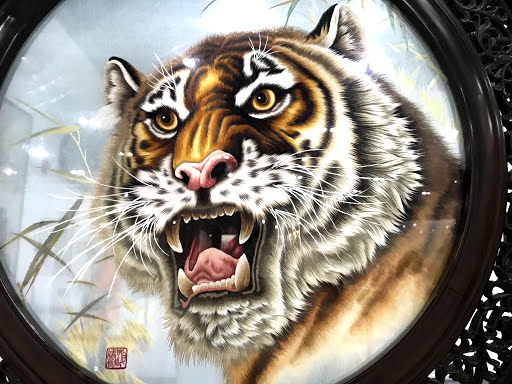 As early as the Spring and Autumn Period, the embroidery in the Hunan area was already developed. By the Qing Dynasty, Xiang embroidery was trendy all around Hunan. It was quite common to see ordinary people making embroideries. Originated in folk embroidery, the Xiang Embroidery absorbed from the Su embroidery and Yue embroidery. It implanted many creations from traditional Chinese paintings to embroideries and fully applied different stitching methods to make more delicate works.
As early as the Spring and Autumn Period, the embroidery in the Hunan area was already developed. By the Qing Dynasty, Xiang embroidery was trendy all around Hunan. It was quite common to see ordinary people making embroideries. Originated in folk embroidery, the Xiang Embroidery absorbed from the Su embroidery and Yue embroidery. It implanted many creations from traditional Chinese paintings to embroideries and fully applied different stitching methods to make more delicate works.
The traditional patterns of Xiang embroidery are lions, tigers, and squirrels, among which tigers are common. There is a reputation that the Xiang embroidery was so vivid that one can almost smell the fragrance of the embroidered flowers, hear the embroidered bird's sound, see the embroidered tiger running and understand what’s in the embroidered figure's mind.
Cantonese embroidery, one of China's four great embroideries, is the general term of Guangdong embroidery and Chaoshan embroidery.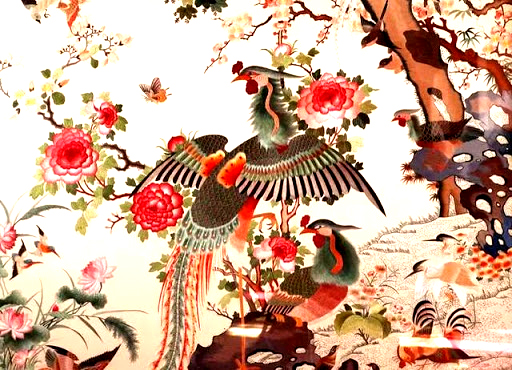 It has a history of over 1000 years. During Tang Xuanzong's ruling, the military commander of Lingnan Zhang Jiugao offered a piece of embroidery work to Lady Yang, which was much appreciated. As a result, he was offered a three-level promotion. This story indicated that Yue embroidery was already developed in the Tang Dynasty. By the middle period of the Ming Dynasty, the convenient coastal trade in Guangdong had enabled Yue embroidery to be famous overseas. In the Qing Dynasty, Queen Elizabeth I established the British Embroidery Association to promote embroidery development. King Charles also encouraged the British people to spread Yue embroidery crafts. For a time, the Yue embroidery was hailed as "a gift from China to the West."
It has a history of over 1000 years. During Tang Xuanzong's ruling, the military commander of Lingnan Zhang Jiugao offered a piece of embroidery work to Lady Yang, which was much appreciated. As a result, he was offered a three-level promotion. This story indicated that Yue embroidery was already developed in the Tang Dynasty. By the middle period of the Ming Dynasty, the convenient coastal trade in Guangdong had enabled Yue embroidery to be famous overseas. In the Qing Dynasty, Queen Elizabeth I established the British Embroidery Association to promote embroidery development. King Charles also encouraged the British people to spread Yue embroidery crafts. For a time, the Yue embroidery was hailed as "a gift from China to the West."
Even now, the British, French, German, and American museums still have Cantonese embroidery collections. Unlike any other embroideries, the Yue embroidery was mainly completed by men, which was very rare. Those embroideries were used primarily as decorations on clothes, hanging screens, pouches worn at the girdles, moon-shaped fans, and fan covers. The patterns were mainly phoenix, peony, crane, chimp, deer, rooster, and goose. Many kinds of colors were applied, and the stitches were relatively simple and loose. There was another famous kind of Yue embroidery - Dingjin embroidery. It looks very splendid and is mainly used on costumes or as furnishings on stages and temples to render a warm and festive atmosphere.
Shu embroidery, also called Sichuan embroidery, has a long history. According to Records of Huayang from the Jin Dynasty, the Shu embroidery was already famous in the Jin dynasty. Together with Shu brocade, Shu embroidery made special goods in Sichuan. 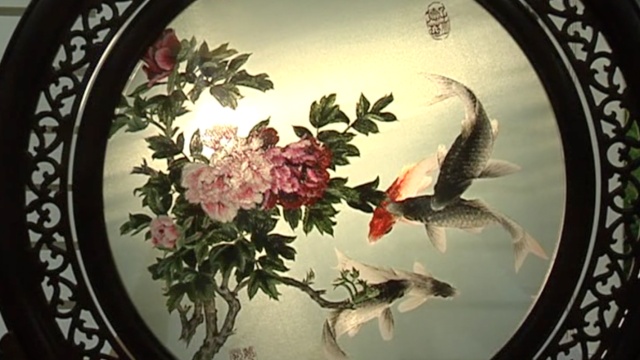 In today's embroidery works, there are relatively fewer ornamental embroideries. Most of them are used on daily necessities. It can be on a big scale or almost invisibly small. For instance, the vast Pedestal Screen of Hibiscus and Carp, the Hanging Screen of Females Playing Music, and the pedestal screens of giant and little pandas of the Sichuan hall of the Great Hall of the People are all representatives of Shu embroidery.
In today's embroidery works, there are relatively fewer ornamental embroideries. Most of them are used on daily necessities. It can be on a big scale or almost invisibly small. For instance, the vast Pedestal Screen of Hibiscus and Carp, the Hanging Screen of Females Playing Music, and the pedestal screens of giant and little pandas of the Sichuan hall of the Great Hall of the People are all representatives of Shu embroidery.
Shu embroidery originated from the folk embroidery in western Sichuan province. The environment, social customs, culture, and art have impacted the Shu embroidery and helped to form its characteristics of smooth and bright threads, neat and rigorous stitches, soft colors, and appropriate use of virtuality and reality. Any Shu embroidery work can show these unique crafts. According to statistics, there are altogether 122 kinds of stitching methods, the most commonly used one is Yun stitching, which can help show the texture of the embroidery and reflect the light, color, and shape of the patterns. Meanwhile, different degrees of thick or thin threads are used to illustrate the patterns' postures better. Besides, Shu embroidering skills can be flexible and adaptive. Based on the different base materials and patterns, different threads and colors are applied.
As a widely popular handicraft in China, Chinese embroidery can be found almost everywhere. There are also many famous local embroideries besides the four extraordinary embroideries. The minority groups also have their own unique embroidery cultures. If you travel to China, don’t forget to admire one or two pieces of local embroideries.
Copyright © 2019 Lily Sun China Tours International, Inc. Terms &conditions | Privacy Policy | Sitemap